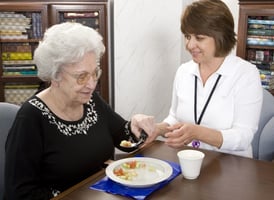For someone recovering from surgery, illness or an accident, the threat of falling can be as much...
Is Your Loved One Losing Vision? 5 Tips for Finding Out – and Keeping Them Safe
The needs of family members with vision loss traditionally go underserved, if for no other reason than the patients themselves often don’t realize – or have difficulty admitting – they have difficulty seeing.
“We tend to recognize poor vision in our parents or other loved ones before they do,” says Wendy Fishman, director of rehabilitation services at Visiting Nurse Association of Ohio.
“There are some key things to look for if you suspect a family member is losing vision,” says Fishman. “If you notice these signs, be sure to be supportive and helpful and encourage a check-up at the eye doctor.”
1. Does a loved one have trouble detecting contrast between two surfaces?
This could be a major safety hazard, especially at the edges of steps and corners of hallways.
Safety tip: Place brightly colored tape where surfaces meet.
2. Does a loved one have trouble reading?
If so, this poses a major problem: mistaking one medication for another. This is often indicated when a person has trouble seeing the television or reading a letter or menu at a restaurant.
Safety tip: Keep a simple, handheld magnifier in the medicine cabinet, where mail is placed and by each telephone.
3. Does a loved one live in an accident-prone environment?
Your family member could injure himself in any number of ways in an unorganized home.
Safety tips: Be thoughtful about what you place where. For example, toothpaste shouldn’t sit next to a similarly shaped tube of medical ointment. Diabetes supplies should be contained in an easy-to-carry storage box, not spread about in different locations. Daytime medicines should be kept separate from nighttime medicines.
4. Does a loved one avoid visiting you?
If so, it could be because your home is difficult to navigate. You might notice when there’s a child’s toy on the floor, but a loved one experiencing vision loss might not.
Safety tip: Do a routine walk-through of your home regularly, looking for potential obstacles. Keep walkways clutter-free. Think of your loved one when re-arranging furniture – will the new setup work? Note: Always alert loved ones that you’ve re-arranged furniture or changed the layout of a room.
5. Does your loved one avoid public spaces, like restaurants or shopping malls?
Your loved one deserves to live a full life, including eating out and shopping. But a fear of being able to navigate a public place could prevent your family member from leaving the house.
Safety tip: When making a reservation, advise the host that a member of your party has low vision. Ask for a table in a convenient location: near the restrooms, close to the entrance, etc. In a mall, take sit-down breaks as needed. When in doubt, become familiar with a new location first, so you can assist your loved one better.
What causes vision loss?
Vision loss is common among older patients, but it can affect people of all ages through conditions such as macular degeneration, advanced diabetic retinopathy, glaucoma and congenital conditions. And it’s not the same for everyone. There are five different types of vision loss including:
1. The inability to clearly see small print.
2. A sensitivity to light glare and an associated inability to detect contrast.
3. A lack of peripheral vision.
4. Impairment that affects the central visual field.
5. Uncontrolled eye movement that causes double vision.
Visiting Nurse Association of Ohio nurses and therapists can help family members better address the needs of family members with low vision by developing an appropriate care plan.
“We can’t help change or reverse patients’ vision loss,” says Fishman, “But we can help them use what they have left and give them strategies and ideas to help them be at their maximum,” she adds.
Call VNA of Ohio Today
Learn more about VNA of Ohio rehabilitation therapy services, or call us today at 1-877-698-6264.



